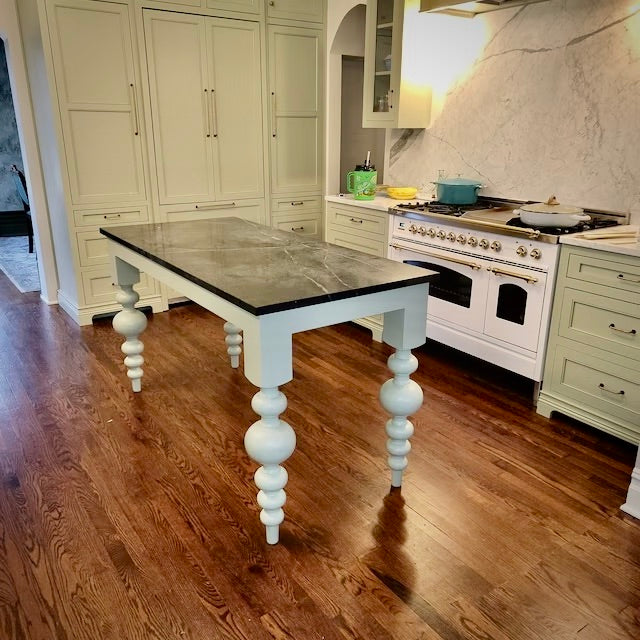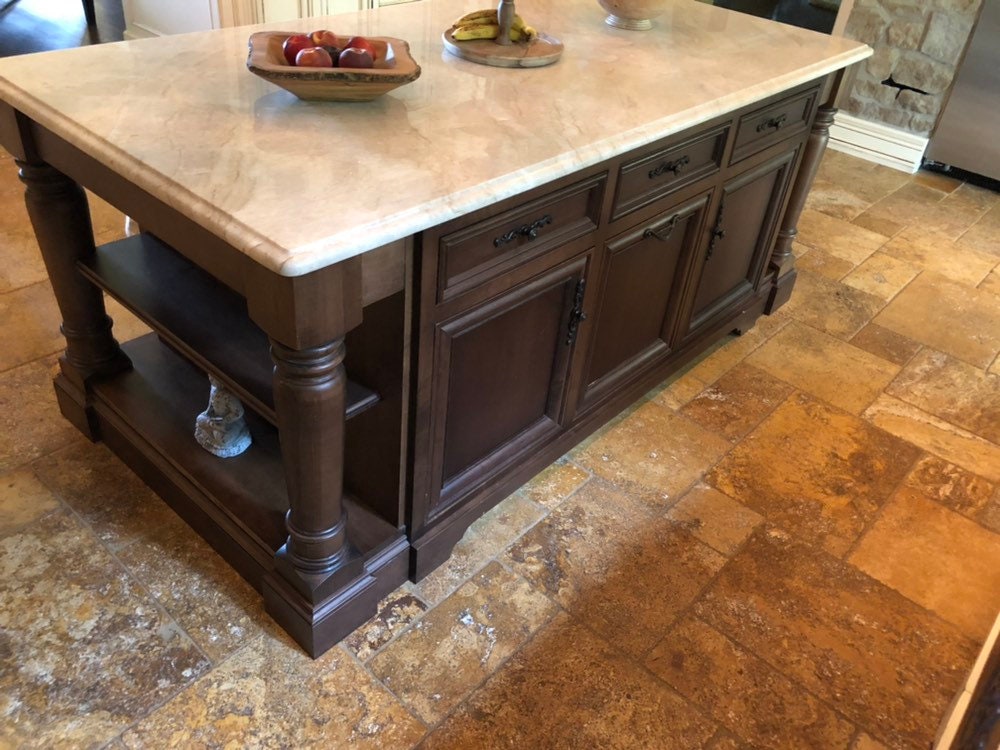Custom-made Kitchen Island Legs to Match Your Kitchen Visual
Custom-made Kitchen Island Legs to Match Your Kitchen Visual
Blog Article
Crucial Tips for Choosing the Perfect Table for Your Cooking Area
Selecting the perfect dining table for your cooking area is even more than simply a matter of preference; it necessitates a thorough understanding of your room and needs. Begin by determining your available area to ensure enough clearance for motion. The form of the table plays a crucial function; while rectangle-shaped tables match larger areas, round ones foster affection, and extendable options supply versatility. Material option is equally critical, with woods giving sturdiness and glass lending a contemporary touch. Finally, the table should integrate with your kitchen's looks and suit your family conveniently. What various other elements might influence this crucial choice?
Procedure Your Area
Picking the perfect table starts with a precise analysis of your offered room. This fundamental step makes sure that the table not just fits easily within the area yet likewise enhances the overall design and functionality of your dining location. Begin by determining the dimensions of the area, considering entrances, windows, and any existing furniture. This will help you identify the optimum allowable dimension for your dining table.
Think about the flow of activity around the table. It is important to leave adequate space for chairs to be taken out and for people to walk around the table without blockage. A general general rule is to enable a minimum of 36 inches of clearance from the side of the table to the nearby wall surface or furniture. This guarantees convenience of access and comfort throughout dishes.
In addition, consider the variety of people you normally amuse and whether you require added area for guests. Selecting an extendable table can supply flexibility, permitting you to fit differing numbers of diners. By precisely measuring your room, you prepared for picking an eating table that boosts both the looks and performance of your eating area.
Pick the Right Shape

On the various other hand, round tables are exceptional for smaller kitchen areas or intimate celebrations, as they advertise discussion by enabling everybody to deal with each other. They also give a feeling of comfort and can fit well in tighter spaces as a result of their lack of sharp corners. Oval tables use the most effective of both globes, integrating the size of rectangle-shaped tables with the intimacy of rounded ones, making them functional for various settings.
Square tables are one more choice, specifically suited for square-shaped areas. They develop a contemporary and in proportion appearance, fostering an equivalent eating experience for all seated. Nevertheless, they may be less sensible for bigger celebrations unless they come with expansions. Inevitably, the shape you select should line up with your area dimensions and lifestyle to ensure both type and function.
Material Factors To Consider
When choosing a dining table, product factors to consider are critical in determining the table's resilience, maintenance requirements, and total aesthetic. Wood is a timeless option, supplying ageless allure and robustness.
Glass-topped tables give a modern, streamlined appearance and can make a space appear larger because of their openness. However, they need regular cleaning to protect against spots and fingerprints. Furthermore, tempered glass is suggested for its extra toughness and security.

Lastly, composite materials like MDF (Medium-Density Fiber board) or plywood are budget-friendly choices. These materials can mimic the appearance of solid timber however might not use the same durability. They are normally easier to clean yet can be at risk to water damages if not effectively secured.
Inevitably, the choice of material need to straighten with your kitchen area's design, your lifestyle needs, and your budget plan restrictions. (kitchen island legs)
Seats Ability and Comfort
How do you determine the appropriate seating capacity and convenience for your dining table? This crucial step entails assessing both the physical space readily available in your cooking area and your house's practical go to this web-site needs. Begin by gauging your kitchen area to guarantee the table fits conveniently, allowing at the very least 36 inches of clearance around it for simple activity. Think about the number of individuals who typically eat together, as this will certainly influence the table dimension. For a family of four, a rectangle-shaped table of 48 inches long or a round table with a 48-inch diameter is generally adequate.
The elevation of the table should ideally be around 30 inches, giving a well balanced ergonomic position for seated diners. Chairs should have a seat height of 18 to 20 inches to make sure a comfy see this website dining pose.
Design and Aesthetic Appeal
Picking a table that fits your design and looks involves balancing individual preference with the existing decoration of your dining space. The table is usually the focal point of the cooking area, and its design needs to match the general theme of the space. Whether your kitchen flaunts a contemporary, minimalist appearance or a rustic, farmhouse appeal, the table you select ought to harmonize with these components to develop a natural and inviting environment.
Consider products very carefully; timber uses a timeless allure and can vary from abundant mahogany for a traditional aim to lighter oak for a contemporary feeling. Metal and glass tables, on the other hand, can present a smooth, industrial edge to your cooking area. Don't neglect the table's form-- rectangular tables are functional and timeless, while round and oval alternatives can promote an extra intimate dining experience.
Furthermore, pay attention to coatings and information. A troubled coating may include character and heat, whereas a shiny surface area can add to a tidy, contemporary aesthetic. Eventually, your eating table should not only fit perfectly right into your kitchen area's design however additionally reflect your personal style, raising the room both functionally and aesthetically.
Verdict
In final thought, choosing the excellent eating table for a kitchen demands cautious analysis of room, shape, material, seating capacity, and visual consistency. Eventually, a well-chosen eating table fosters an inviting environment and fits the house pleasantly, therefore improving the eating experience.

When choosing an eating table, material factors to consider are extremely important in identifying the table's longevity, maintenance requirements, and total aesthetic. For a family members of four, a rectangular table of 48 inches long or a round table with a 48-inch size is usually adequate.
Don't overlook the table's form-- rectangle-shaped tables are flexible and classic, while round and oblong options can promote a much more intimate eating experience. kitchen island legs.
Report this page